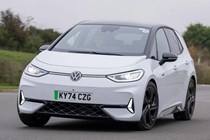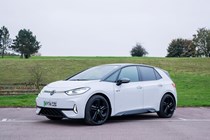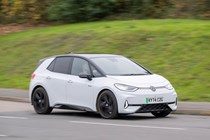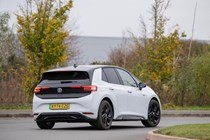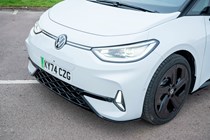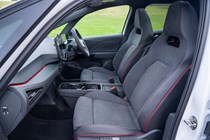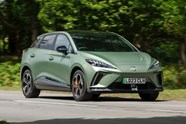
Volkswagen ID.3 GTX review

At a glance
| Price new | £46,325 - £47,120 |
|---|---|
| Used prices | £26,418 - £31,955 |
| Road tax cost | £620 |
| Insurance group | 34 |
Get an insurance quote with

|
|
| Fuel economy | 4.4 miles/kWh |
| Range | 369 miles |
| Miles per pound | 7.0 - 12.9 |
| Number of doors | 5 |
| View full specs for a specific version | |
Available fuel types
Fully electric
Pros & cons
- Plenty of performance
- Great electric range
- Generous equipment levels
- Could be more engaging to drive
- Quite expensive to buy
- Design is a bit bland considering the performance
Volkswagen ID.3 GTX rivals
Overview
Volkswagen had a rocky start when it began making its first bespoke electric cars in 2020 with the ID.3 – a model meant to signal the firm’s third era. The first was its original Beetle and the second was the launch of the Golf. However, some problems with the technology and slightly odd styling of the ID.3 meant it wasn’t the original success that VW hoped for.
A facelift in 2023 improved those two issues, and now Volkswagen is introducing a sportier GTX model, bringing additional performance and sportier styling both inside and out. Other electric Volkswagens have already received the GTX treatment – and with limited success – such as on the ID.4 GTX and ID.Buzz GTX. Both received more power, but ultimately never felt especially fun in our experience. You can read more about how we test cars at Parkers.
So the ID.3 GTX hopes to change that, and as the smallest and best-driving electric Volkswagen, it’s a great place to start. Unlike every other GTX model so far, the ID.3 is rear-wheel-drive – rather than all-wheel-drive – and it gets a significant power bump, too. Usually, every variant of the ID.3 produces 204hp, but the GTX’s newer electric motor develops 326hp – giving it almost the same power as a petrol-powered Volkswagen Golf R.
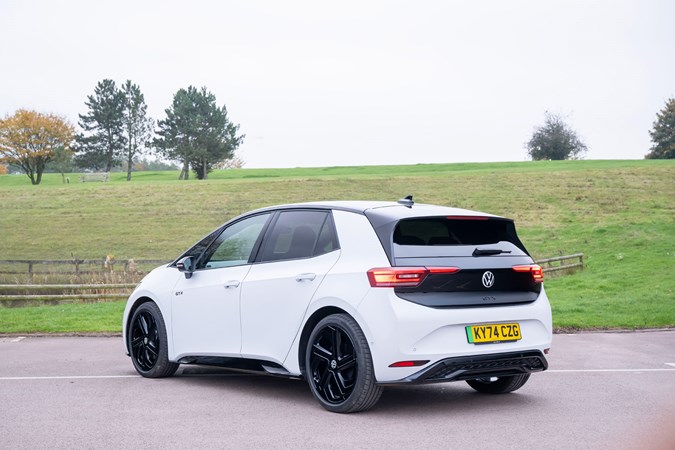
Impressively considering the performance, the GTX also has the longest range of any ID.3, with Volkswagen claiming up to 369 miles, while having some particularly quick charging speeds, which we will explore later.
In terms of visual changes, the GTX plays it safe. The most obvious difference is its new front bumper incorporating new LED daytime running lights, and it also features 20-inch alloy black wheels and different side sills.
Its closest electric hot hatch rival is the Cupra Born VZ, which it shares many components with, but you could also consider a much more powerful yet cheaper MG4 XPower. We also recommend looking at the Alfa Romeo Junior Veloce and Abarth 600e, though they’re not quite as spacious.
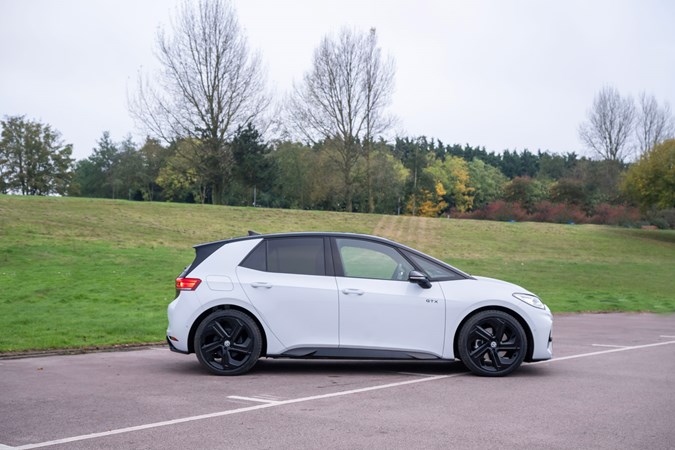
So is the electric Volkswagen ID.3 GTX worth considering, or would you be better off sticking with a regular ID.3 and pocketing the change? Let’s take a look.
What’s it like inside?
Volkswagen has injected the GTX’s interior with some additional sportiness over a regular ID.3, with the most welcome change being its suede and artificial leather sports seats. With red piping and stitching, they look great and are joined by a sports steering wheel and various other red styling elements that certainly breathe some life into the interior. Our test car was also equipped with a glass roof. It’s a £795 option, but worth considering – especially if you have rear passengers – as it helps brighten the cabin significantly.
All ID.3s have a particularly minimalist interior and the GTX is no exception. There are very few physical buttons to play with, and instead, most controls are operated through the main touchscreen. Early ID.3s had glitchy infotainment systems that proved annoying to use in our experience, but with a new system and larger screen, it represents a big improvement in usability. We’d still prefer more physical controls, however, to avoid having to take your eyes off the road to use the screen when adjusting the climate control, for example.
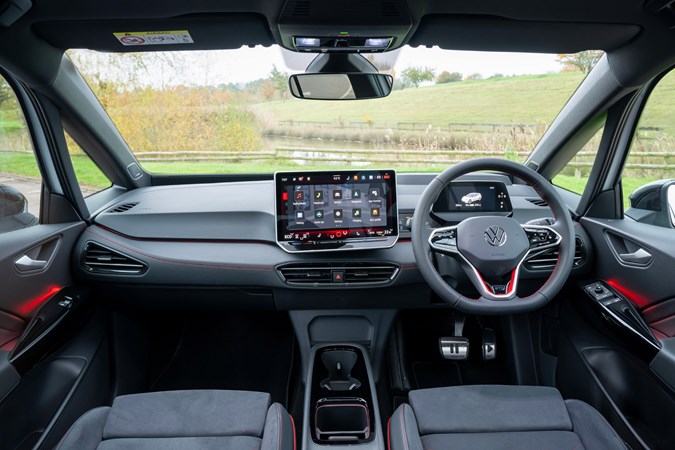
For a car of its size – the dimensions are almost identical to a VW Golf – the ID.3’s interior offers plenty of space. Previously, versions of this hatch fitted with the larger, long-range battery didn’t get a middle rear seat, but the GTX comes with five chairs as standard. It is quite a squeeze for five adults as the ID.3 isn’t particularly wide, but there’s more than enough room for two adults in the back with enough headroom and legroom – helped by an almost flat rear floor. The 385-litre boot is a good size, though has quite a high loading lip. We recommend the £75 adjustable boot floor that avoids this, but it’s poor that it’s not included as standard on a car of this price.
Comfort
The GTX scores plenty of points in the department because it’s the only ID.3 that comes as standard with the usually optional ‘ergoActive’ seats. These offer more support than the regular seats, while coming with electrical adjustment and memory function.

Rear-seat passengers should also travel well because of the ID.3’s large rear windows and well-controlled ride. Again, you might want to consider that optional glass roof here.
Safety
The ID.3 scored five sears when it was tested by Euro NCAP in 2020, with high scores recorded in all areas – especially for child occupant protection, which makes this an appealing small family car.
The standard driver assistance kit is impressive, too, with adaptive cruise control, a reversing camera and all-around parking sensors proving useful. An optional ‘Assistance Package Plus’ brings park assist, blind spot monitoring and rear cross-traffic alert, though is quite expensive to choose at £2,240.
Electric motors
The GTX gets a significantly more powerful electric motor than the standard ID.3, with power increasing from 204hp to 326hp. It’s a lot of pace for something with this footprint, with 0-60mph taking 5.7 seconds, and a 124mph top speed – noteworthy because other ID.3s are capped at 99mph.
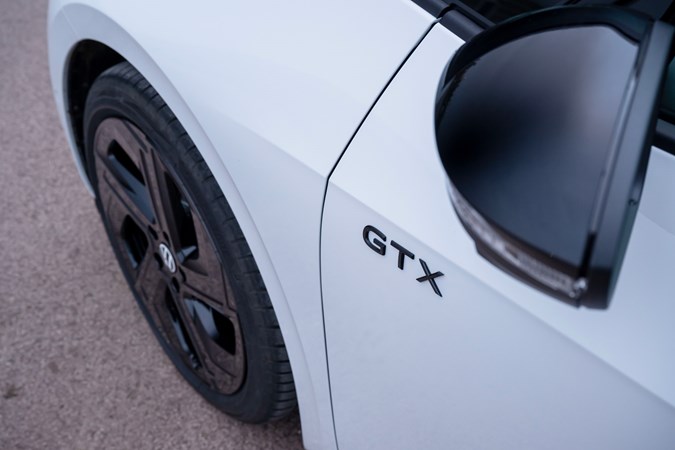
There are also two energy recuperation modes available – Drive (D) or B (Brake) though even in the strongest setting, the regen is very light, and far from the sharp stopping power that a Hyundai Ioniq 5 N provides, for example.
Range and charging
The GTX packs a new 79kWh battery that is the largest fitted to an ID.3 to date. With an improved energy density and efficiency, it gives it the longest electric range of any ID.3 – impressive considering its power output.
Volkswagen claims 369 miles is achievable from a charge, which is a few miles more than the equivalent Cupra Born, but significantly more than the 281-mile claimed range of an MG4 XPower.
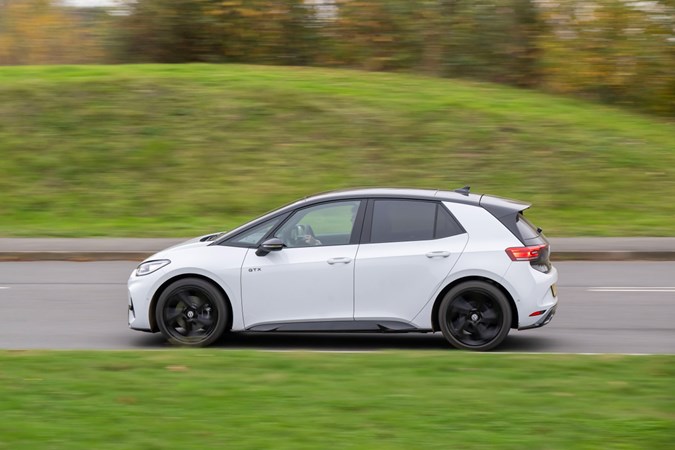
The GTX can also be rapidly charged at up to 185kW, enabling a 10 to 80% charge to take place in just 26 minutes.
What’s it like to drive?
The GTX feels significantly quicker than other ID.3 models – not surprising considering its power advantage. The power is delivered in a very smooth and linear fashion, even by EV standards, with plenty of overtaking potential and speedy getaways, though it never feels quite as fast as you might expect a 326hp hot hatch to be – and certainly nowhere near as fast as the almost-unruly MG4 XPower.
The GTX also comes with Volkswagen’s adaptive chassis control (called DCC) as standard, with the main advantage to this being able to flick between 15 different suspension settings, from the most comfortable to a harsher, sportier ride, with a very clear difference between the two.

It means that even with its large 20-inch alloy wheels, the ride is compliant for the most part, with only several bumps in quick succession unsettling it slightly. It’s a very refined EV, too, and with no attempt to create an engine note – or a sports sound – is quiet on the move, and ideal for long journeys.
While the ID.3 handles well, with precise steering and being able to hold a line through a fast corner, Volkswagen has perhaps been a bit tame with its stability control as it kicks in very early before the rear of the car has even thought about stepping out. Volkswagen compares the GTX to its Golf GTI Clubsport, but the level of thrills between the two are quite different. Instead, this ID.3 feels more like a Golf R in the way it is able to dispatch its speed quickly but always in a fairly safe and predictable fashion. A Cupra Born VZ is the more fun electric car in this class.
What models and trims are available?
This sporty ID.3 comes in only one flavour – GTX Performance. Given it sits at the top of the range, the level of equipment included is impressive – bundling in many of the features that are options on ID.3s.
Standard equipment includes 20-inch alloy wheels, an augmented reality head-up display and heated and electric front seats. A Harman Kardon sound system is also included, along with a large 12.9-inch touchscreen.
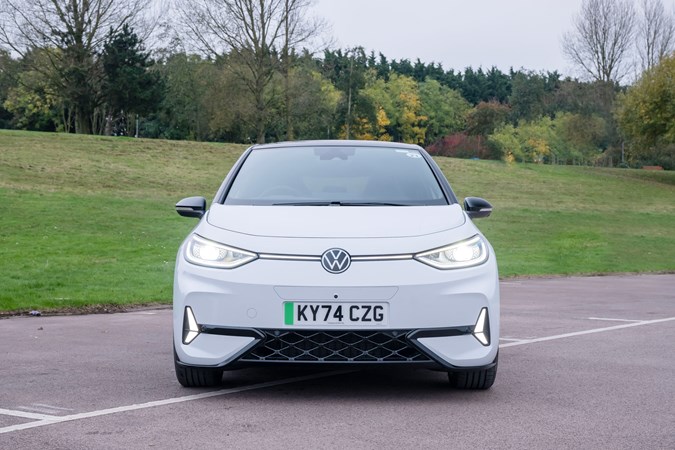
Prices for the ID.3 GTX start from £46,225, putting it at the top end of this class, especially when the mechanically-similar Cupra Born VZ starts from £1,600 less, and also gets a longer five-year warranty.
The options list is quite short but does have a few options you might want to consider – such as a heat pump to boost the car’s range (it should really be included as standard) and the panoramic glass roof.
Read on for the full expert Parkers verdict.


